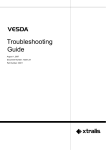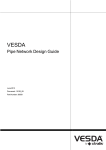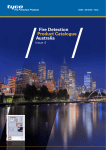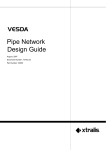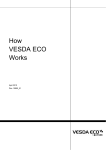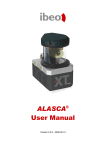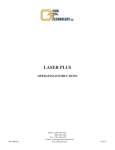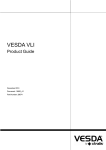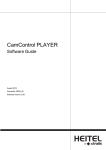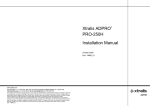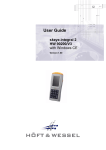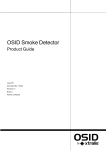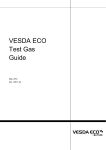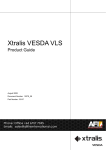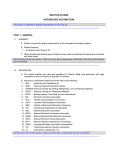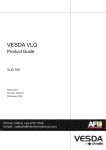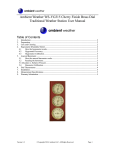Download 12748_06_Product_Gui..
Transcript
ASD Suppression Actuation Threshold (ASAT) Calculator Product Guide July 2007 This page has been left blank intentionally. VESDA® ASD Suppression Actuation Threshold (ASAT) Calculator Product Guide Preface The ASD Suppression Actuation Threshold (ASAT) Calculator is a Microsoft Excel based software tool, developed using Computational Fluid Dynamics (CFD) fire modeling techniques. The function of this tool is to calculate appropriate VESDA alarm thresholds for the purpose of suppression actuation, under a variety of different environmental conditions and for a number of different suppression actuation schemes. Approvals The ASAT Calculator tool has FM Global approval (FM Standard 3230-3250). Copyright ©2007 Xtralis AG. i ASD Suppression Actuation Threshold (ASAT) Calculator Product Guide This page has been left blank intentionally. ii VESDA® VESDA® ASD Suppression Actuation Threshold (ASAT) Calculator Product Guide Contents 1. Coincidence/Double Knock Detection Schemes .................................................................................. 1 2. Using The ASAT Calculator .................................................................................................................... 1 2.1 2.2 2.3 3. General Use .................................................................................................................................. 1 VESDA Detector Exhaust Sampling ............................................................................................. 5 ASAT Fire Alarm Threshold Adjustment ....................................................................................... 6 ASAT Fire Alarm Threshold Evaluation In ASPIRE2 ............................................................................ 8 Appendix – Example ASPIRE2 Design File................................................................................................. 14 Copyright ©2007 Xtralis AG. iii ASD Suppression Actuation Threshold (ASAT) Calculator Product Guide This page has been left blank intentionally. iv VESDA® VESDA® 1. ASD Suppression Actuation Threshold (ASAT) Calculator Product Guide Coincidence/Double Knock Detection Schemes One method for minimizing the possibility of false discharges involves using a coincidence (double knock) detection scheme. The “coincidence connection” configuration requires that at least two independent detector alarm outputs be signalled to the detection control and indicating equipment before suppression is actuated. Making coincidence (double knock) detection a prerequisite to suppression actuation, avoids unnecessary false alarm triggered suppression releases. There are five suggested coincidence (double knock) detection options, for which the ASAT Calculator will determine appropriate VESDA alarm threshold levels for suppression actuation: 1. 2. 3. 4. 5. Hybrid Detection Technologies Option – Point (spot) type smoke detectors and VESDA detectors, both either on the ceiling or within the floor void, together form a coincidence detection scheme. Alternating VESDA Sampling Pipe Option – Two different VESDA detectors, with their respective sampling pipes alternated, both either on the ceiling or within the floor void, can maintain the required sampling hole spacing while providing two independent detectors for coincidence detection. VESDA Detector Exhaust Sampling Option – Coincidence detection is provided by one VESDA detector sampling the exhausts of up to four other VESDA detectors on the ceiling, in the floor void or both. VESDA Ceiling (Floor Void)/AHU Sampling Option – Two different VESDA detectors, one with its sampling pipe mounted on the ceiling (or in the floor void) and the other across the AHU’s return air vent, provide coincidence detection. Single VESDA Detector Options – (a) Two of the VESDA system multiple alarm levels can be set at appropriate levels to provide a coincidence detection scheme using a single VESDA detector. The alarm setting should be comparable to that for conventional point (spot) type smoke detectors, (b) Pairs of adjacent VESDA LaserSCANNER (VLS) sampling pipes may also be used to provide two alarms. One advantage of using this option is having two signals from two independent detection sectors. For more information on any of these options, refer to the Telecommunications And Data Processing Facilities Design Guide (Xtralis Document Number 11782). 2. Using The ASAT Calculator 2.1 General Use The instructions in this Section will guide you through the use of the ASAT Calculator to determine the appropriate VESDA alarm thresholds for coincidence detection (double knock) options 1, 2, 4 and 5 above. Coincidence detection (double knock) option 3 is addressed in Section 2.2. 1. 2. Double click on the ASAT Calculator file name to open it in Microsoft Excel. Enable Macros to display the initial screen of the ASAT Calculator (Figure 1). 1 ASD Suppression Actuation Threshold (ASAT) Calculator Product Guide VESDA® Figure 1 – Initial screen of the ASAT Calculator. 3. 4. 5. 2 Select the Units you want your calculations in by clicking the corresponding radio button. Click on the About button, if you would like to view product information. Click on the Proceed to Calculator button, if you are ready to make calculations. The following screen (Figure 2) will be displayed. Note that, had you selected Imperial units, the screen displayed would reflect this selection. VESDA® ASD Suppression Actuation Threshold (ASAT) Calculator Product Guide Figure 2 – ASAT Calculator main screen. 6. 7. 8. 9. Under Detection Method, select the type of enclosure by clicking on the radio button (ceiling or floor void). In the text boxes under Design Parameters, enter the air change rate in the area to be protected, room area, the ceiling height, the nominal point (spot) type smoke detector sensitivity that you wish the VESDA system to be equivalent to and the preferred sampling hole spacing. For air change rates of less than 5 per hour, you should use the group sensitivity feature of ASPIRE2 to determine the alarm threshold. This feature is discussed later under “ASAT Fire Alarm Threshold Evaluation In ASPIRE2” section 3. Select the type of return air circulation, most appropriate to the area to be protected, by clicking on the radio button. CRAC stands for Computer Room Air Conditioning. Click on the Calculate button. The following screen (Figure 3) will be displayed. 3 VESDA® ASD Suppression Actuation Threshold (ASAT) Calculator Product Guide Figure 3 – Screen showing the results from the ASAT Calculator. The suppression actuation threshold is displayed on the right of the screen, along with the maximum number of sampling holes. Table 1 gives the maximum number of sampling holes allowed for each VESDA detector type. Table 1 – Maximum number of sampling holes for each VESDA detector type. Note: Detector Type Max allowed no. of sampling holes VLF-250 12 VLF-500 25 VLC 40 VLP 100 You must also consult and adhere to any local codes and standards recommendations on detection point spacing The ASAT Calculator produces a log as part of its calculation process. This log, an Excel spreadsheet, contains a record of the input and output parameters of the calculations performed. To view this log, move the ASAT Calculator dialog box aside by dragging and dropping it. The under lying spreadsheet can be printed using the Print option on the File menu in Excel. 4 VESDA® ASD Suppression Actuation Threshold (ASAT) Calculator Product Guide WARNING: 2.2 The VESDA alarm thresholds calculated by this tool are estimates only. They MUST be verified using the ASAT Verification and Commissioning Procedure (Xtralis Document Number 12746), before the system is put into operation. VESDA Detector Exhaust Sampling If you are employing the coincidence detection option involving VESDA detector exhaust sampling (that is, option 3 in Section 1), you must determine peak smoke levels for each of the VESDA detectors whose exhausts will be sampled. 1. Click on the Details button under VESDA Exhaust Sampling in Figure 3. The following screen (Figure 4) will be displayed. Figure 4 – ASAT Screen showing the test procedure needed to calculate the appropriate alarm threshold for the exhaust sampling detector. 2. 3. 4. 5. Check the Same as previous box if the project is of the same name as on the previous screen (Figure 3). Follow the procedure outlined in the above screen (Figure 4). Enter the peak smoke levels obtained for each of the VESDA detectors whose exhausts will be sampled. Up to four VESDA detectors can have their exhausts sampled by another VESDA Coincidence Detection Detector (CDD). Click the Calculate button to obtain the alarm threshold for the CDD, based on the number and sensitivities of the VESDA detectors. The result will be displayed on the right as shown (Figure 5). 5 ASD Suppression Actuation Threshold (ASAT) Calculator Product Guide VESDA® Figure 5 – ASAT screen showing the CDD alarm threshold appropriate to the number of VESDA detectors and their sensitivities. 6. 2.3 If you have more VESDA detectors with a corresponding CDD, you can repeat the above steps by clicking on the Add Detector button to display Figure 4. ASAT Fire Alarm Threshold Adjustment The ASAT Fire alarm threshold, determined previously, only applies to one VESDA detector assigned for the protection of the entire enclosure. When two or more VESDA detectors are required to cover the entire enclosure, the ASAT Fire alarm threshold must be adjusted. The objective of these adjustments is to achieve identical sampling hole sensitivity across all VESDA detectors. Follow the steps below to make the necessary adjustments: 1. 2. 3. 4. 6 Take note of the ASAT Calculator, generated, Fire alarm threshold and total number of sampling holes, as determined in Section 2.1. Determine the number of detectors required in the protected enclosure (detail design). Determine the number of sampling holes contributed by each detector (Table 1). The adjusted ASAT Fire alarm threshold for each detector is determined by the following formula: ASAT Value x Total No. of Sampling Holes Detector (Fire Alarm) = No. of Sampling Holes for Detector VESDA® ASD Suppression Actuation Threshold (ASAT) Calculator Product Guide For example, consider an area with the following parameters: • • • • • Enclosure area: 1800 m2 (19,365 sq.ft), Air change rate/hour: 30 ACH, Enclosure height: 3 m (10 ft), Point (spot) type smoke detector nominal sensitivity: 5%Obs/m (1.5%Obs/ft), VESDA sampling hole spacing: 5 m (16.5 ft). The ASAT Calculator Outputs are as follows: • Fire alarm threshold: 0.285%Obs/m (0.086%Obs/ft), • Total No. of sampling holes: 72. Table 2 shows the adjusted ASAT Fire threshold for different design cases. Note that Table 2 takes into account the maximum number of sampling holes for each VESDA detector type as presented in Table 1. Table 2: Adjusted ASAT Fire alarm threshold Design Case No. & Type of Detectors No. of Sampling Holes per Detector Adjusted ASAT Fire Threshold per Detector -%Obs/m (%Obs/ft) 1 1 x VLP VLP = 72 0.285 (0.086)* 2 2 x VLC VLC (1) = 36 0.570 (0.174) VLC (2) = 36 0.570 (0.174) 1 x VLC VLC = 40 0.513 (0.156) 1 x VLF-250 VLF-250 = 12 1.710 (0.521) 1 x VLF-500 VLF-500 = 20 1.026 (0.313) VLF-500 (1) = 24 0.855 (0.261) VLF-500 (2) = 24 0.855 (0.261) VLF-500 (3) = 24 0.855 (0.261) VLF-250 (1) = 12 1.71 (0.521) 2 x VLF-250 VLF-250 (2) = 12 1.71 (0.521) 2 x VLF-500 VLF-500 (1) = 24 0.855 (0.261) VLF-500 (2) = 24 0.855 (0.261) 3 4 5 3 x VLF-500 * This value corresponds to the ASAT output since one VESDA detector is assigned for the entire enclosure. 7 ASD Suppression Actuation Threshold (ASAT) Calculator Product Guide 3. VESDA® ASAT Fire Alarm Threshold Evaluation In ASPIRE2 The ASPIRE2 Pipe Network Modeling Program can be used to evaluate the VESDA Fire alarm thresholds output by the ASAT Calculator. This evaluation involves the use of an ASPIRE2 advanced feature known as Group Sensitivity. The use of Groups allows a collection of sampling holes (Figure 6) to have the same performance target and be treated the same by ASPIRE2. Normally, all sampling holes on a pipe network would be a single group, however, this is not always appropriate. Figure 6 – Example of grouped sampling holes (four holes group). The Groups feature allows you to flexibly assign sampling holes to groups and place different aggregate sensitivity constraints on each group. A collection of sampling holes that are in a slightly different environment to other sampling holes in their pipe network can be put in a separate group. For example, where there are sampling pipes on the ceiling of a room with a number of sampling holes covering a return air vent, the return air sampling holes can be grouped to ensure that they are treated consistently. Groups can also be used where a different aggregate sensitivity is required at the return air vent than at the ceiling. The flow chart (Figure 7) outlines the steps to be followed when using ASPIRE2 to evaluate the Fire alarm thresholds output by the ASAT Calculator. 8 VESDA® ASD Suppression Actuation Threshold (ASAT) Calculator Product Guide Figure 7 – Flow chart illustrating the process for ASPIRE2 evaluation of ASAT Calculator Fire alarm thresholds. 9 ASD Suppression Actuation Threshold (ASAT) Calculator Product Guide VESDA® The example below involves two point (spot) type smoke detectors with sensitivity of 5%Obs/m (1.5%Obs/ft) being used to provide coincidence (double knock) detection for suppression actuation. Suppose that, the relevant information has been input to the ASAT Calculator and that the result is a VESDA Fire alarm threshold of 1.599%Obs/m (0.5%Obs/ft) as shown below (Figure 8). Figure 8 – Output from the ASAT Calculator to be used for VESDA Fire alarm threshold evaluation in ASPIRE2. 1. Run the ASPIRE2 program. The following screen (Figure 9) will be displayed. Figure 9 – General tab of the ASPIRE2 pipe network modelling program GUI. 2. 3. 4. 5. 10 Add a detector. Add a pipe network. On the General tab, set the Fire threshold to the value output by the ASAT Calculator, that is, 1.599%Obs/m (0.5%Obs/ft) in this case. Click on the Group Details tab. The following screen (Figure 10) will be displayed. Set the upper limit Target Aggregate Sensitivity and Target Hole Sensitivity equal to the spot detector nominal sensitivity that has been input to the ASAT tool: 5%Obs/m (1.5%Obs/ft) in this case. VESDA® ASD Suppression Actuation Threshold (ASAT) Calculator Product Guide Figure 10 – Group Details tab of the ASPIRE2 pipe network modeling program GUI. The sensitivity of each VESDA sampling hole is calculated on the assumption that smoke enters a specified hole only; with all other holes receiving clean air, which will dilute the aggregate sample. This is a very conservative assumption since smoke will spread throughout the enclosure, reaching multiple holes. The ASAT Calculator derived Fire alarm threshold is based on the fact that smoke will enter more than two VESDA sampling holes. It is therefore, appropriate to employ the Group Sensitivity concept for evaluating the Fire alarm threshold in ASPIRE2, rather than single hole sensitivity. 6. Click on the Add button (Figure 11) to create a new group. Figure 11 – Grouping sampling holes. 7. Tick the sampling holes to appear in the group as shown (Figure 12). Three holes have been ticked here. 11 ASD Suppression Actuation Threshold (ASAT) Calculator Product Guide VESDA® Figure 12 – Three sampling hole grouping. Each of the three sampling holes must sample smoke at a level of 4.461%Obs/m (1.36%Obs/ft) in order for 1.599%Obs/m (0.5%Obs/ft) to be recorded at the VESDA detector. Note that the aggregate sensitivity, in this case, is less than the target hole sensitivity, therefore, the ASAT Calculator Fire alarm threshold value is reasonable. 8. Now make a group of four sampling holes, like that shown below (Figure 13). Figure 13 – Four sampling hole grouping. Each of the four sampling holes must sample smoke at a level of 3.399%Obs/m (1.036%Obs/ft) in order for 1.599%Obs/m (0.5%Obs/ft) to be recorded at the VESDA detector. Again, the aggregate sensitivity is less than the target hole sensitivity. 12 VESDA® ASD Suppression Actuation Threshold (ASAT) Calculator Product Guide In summary, when evaluating ASAT Calculator Fire alarm threshold values, it is only necessary to consider the aggregate sensitivity of a group of sampling holes in relation to the target hole sensitivity. If the aggregate sensitivity of a group of holes is greater than the target hole sensitivity, the designer may consider one of the following options: • Regrouping sampling holes. • Adjusting the ASPIRE2 design. Users wishing to recreate the example illustrated in this document can find the details of the ASPIRE2 design in the Appendix. 13 VESDA® ASD Suppression Actuation Threshold (ASAT) Calculator Product Guide Appendix – Example ASPIRE2 Design File Detector: Type Endcap Usage Application Aspirator Speed Fire Threshold Temperature Absolute Pressure System Flowrate Manifold Pressure Total Pipe Length Number Of Sampling Points Maximum Transport Time Minimum Hole Flow Rate VESDA LaserPLUS Create a Balanced Design Default 3000rpm 1.599%/m 20.0°C 1013.5hPa 36.4l/min 168Pa 40.00m 9 60sec 2.0l/min Pipe:[New Pipe] Total Pipe Length Ambient Pressure Sector Pressure Number Of Sampling Points Pipe Flowrate 40.00m 0Pa 168Pa 9 36.4l/min Section1 Item 14 Distance m Relative m Hole Diameter mm Capillary Length m Transport Time sec Pressure Pa Flow l/min Flow % Hole Sensitivity %/m Diameter mm - Bend 2.67 2.67 - - - - - - - - - Bend 5.34 2.67 - - - - - - - - 1 Hole 8.00 2.66 3.0 - 5 144 4.5 12.4 12.934 21.0 2 Hole 12.00 4.00 3.0 - 7 134 4.3 11.9 13.400 21.0 3 Hole 16.00 4.00 3.0 - 9 126 4.2 11.5 13.849 21.0 4 Hole 20.00 4.00 3.0 - 12 118 4.1 11.2 14.275 21.0 5 Hole 24.00 4.00 3.0 - 15 112 4.0 10.9 14.667 21.0 6 Hole 28.00 4.00 3.0 - 18 107 3.9 10.6 15.015 21.0 7 Hole 32.00 4.00 3.0 - 23 103 3.8 10.4 15.312 21.0 8 Hole 36.00 4.00 3.0 - 31 100 3.7 10.3 15.547 21.0 9 Endcap 40.00 4.00 3.0 - 45 98 3.9 10.7 14.975 21.0 VESDA® ASD Suppression Actuation Threshold (ASAT) Calculator Product Guide Disclaimer On The Provision Of General System Design Recommendations Any recommendation on system design provided by Xtralis is an indication only of what is considered to be the most suitable solution to meet the needs of the common application environments described. In some cases the recommendations on system design provided may not suit the unique set of conditions experienced in a particular application environment. Xtralis has made no inquiry nor undertaken any due diligence that any of the recommendations supplied will meet any particular application. Xtralis makes no warranty as to the suitability or performance of any recommendation on system design. Xtralis has not assessed the recommendation on system design for compliance with any codes or standards that may apply nor have any tests been conducted to assess the appropriateness of any recommendations on system design. Any person or organization accessing or using a recommendation on system design should, at its own cost and expense, procure that the recommendation on system design complies in all respects with the provision of all legislation, acts of government, regulations, rules and by-laws for the time being in force and all orders or directions which may be made or given by any statutory or any other competent authority in respect of or affecting the recommendation on system design in any jurisdiction in which it may be implemented. Xtralis products must only be installed, configured and used strictly in accordance with the General Terms and Conditions, User Manual and product documents available from Xtralis. Xtralis accepts no liability for the performance of the recommendation on system design or for any products utilized in the implementation of the recommendation on system design, aside from the General Terms and Conditions, User Manual and product documents. No statement of fact, drawing or representation made by Xtralis either in this document or orally in relation to this recommendation on system design is to be construed as a representation, undertaking or warranty. To the extent permitted by law, Xtralis excludes liability for all indirect and consequential damages however arising. For the purposes of this clause, ‘consequential damage’ shall include, but not be limited to, loss of profit or goodwill or similar financial loss or any payment made or due to any third party. Recommendations on system design are provided exclusively to assist in design of systems using Xtralis products. No portion of this recommendation on system design can be reproduced without the prior approval in writing of Xtralis. Copyright and any associated intellectual property in any such recommendations on system design or documentation remains the property of Xtralis. 15 ASD Suppression Actuation Threshold (ASAT) Calculator Product Guide VESDA® www.xtralis.com The Americas +1 781 740 2223 Continental Europe +41 55 285 99 99 Asia +852 2297 2438 UK and the Middle East +44 1442 242 330 Australia and New Zealand +61 3 9936 7000 The contents of this document are provided on an “as is” basis. No representation or warranty (either express or implied) is made as to the completeness, accuracy or reliability of the contents of this document. The manufacturer reserves the right to change designs or specifications without obligation and without further notice. Except as otherwise provided, all warranties, express or implied, including without limitation any implied warranties of merchantability and fitness for a particular purpose are expressly excluded. This document includes registered and unregistered trademarks. All trademarks displayed are the trademarks of their respective owners. Your use of this document does not constitute or create a licence or any other right to use the name and/or trademark and/or label. This document is subject to copyright owned by Xtralis AG (“Xtralis”). You agree not to copy, communicate to the public, adapt, distribute, transfer, sell, modify or publish any contents of this document without the express prior written consent of Xtralis. Doc. 12748_06 Part. 21187 16






















